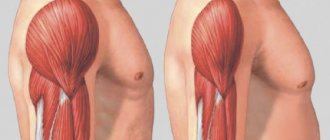About plantar fasciitis
The plantar fascia is a ligament (a band of tough tissue) that connects the heel bone to the ball of the foot (see Figure 1). The plantar fascia acts like an elastic band that stretches with every step. It also supports the arch of the foot.
Figure 1. Plantar fascia
When the plantar fascia is overused or damaged, it can become torn, weakened, swollen, or painful. This condition is called plantar fasciitis. Plantar fasciitis is one of the most common causes of heel pain.
to come back to the beginning
Diagnosis of the disease
In most cases, a clinical examination by a specialist is sufficient to establish a diagnosis. Typical clinical symptoms directly indicate that the patient has plantar fasciitis. In doubtful cases, the following is used for differential diagnosis:
- X-ray examination of the foot;
- ultrasound heel scan;
- MRI of the foot.
Even with X-rays, a bone spur may be visible. Ultrasound complements the examination, since some small bone growths are not always visible radiographically. In addition, ultrasound can detect osteoporosis. Magnetic resonance examination is carried out in extreme cases, but it is the most informative, as it has the highest resolution. In addition, the tomograph will allow you to see the condition of the plantar fascia itself.
Causes of plantar fasciitis
Some causes of plantar fasciitis include:
- tight calf muscles or Achilles tendons (tight tissue that connects the calf muscles to the heel bone);
- prolonged walking, standing or running, especially on hard surfaces;
- wearing shoes that don't fit;
- wearing shoes that do not provide the necessary support for the foot;
- weakening of foot tissues with age;
- flat feet, high arches, or uneven gait;
- overweight;
- pregnancy or hormonal changes; under the influence of hormones, ligaments and tissues may become more mobile than usual.
to come back to the beginning
Treatment of plantar fasciitis
Although plantar fasciitis usually resolves without causing long-term problems, it can last anywhere from 6 to 18 months.
You may need to take medicine to reduce pain and swelling. Your doctor will tell you which of these drugs is best for you. You should always take your medications as directed by your doctor.
The most common medications taken for this condition are nonsteroidal anti-inflammatory drugs (NSAIDs). Examples of NSAIDs:
- ibuprofen (Advil® and Motrin®);
- naproxen sodium (Aleve®);
- naproxen (Naprosyn®).
NSAIDs should be taken with food. Check with your doctor before taking NSAIDs if you:
- have previously consulted a doctor due to diseases of the stomach and intestines, liver or kidneys;
- have previously consulted a doctor due to bleeding disorders;
- are taking aspirin or other medicine that prevents blood clotting;
- are taking corticosteroids, which are steroid hormones produced by the adrenal cortex (the outer part of the adrenal glands).
For more information, read Common Medications Containing Aspirin and Other Nonsteroidal Anti-inflammatory Drugs (NSAIDs) (
Your doctor may also suggest applying tape to the arch of your foot or placing special support products in your shoes, such as heel insoles, orthotics (such as braces or splints), or arch supports. You may also need physical therapy.
If these treatments do not help, contact your doctor. You may be offered other methods, such as corticosteroid injections or surgery.
to come back to the beginning
Characteristics of the disease
Plantar fasciitis is an inflammatory process in the area of attachment of the plantar aponeurosis and all surrounding perifascial structures to the periosteum of the calcaneal tubercle. Inflammation develops as a result of increased extensibility of the fascia, which leads to chronic microtrauma with ruptures of the aponeurosis and the subsequent development of the degenerative process. Synonyms for fasciitis are heel spur, subcalcaneal pain, painful heel syndrome, calcaneodynia.
Anatomy and function of aponeurosis
The plantar aponeurosis runs from the medial tubercle of the calcaneus to the proximal phalanges of the toes. Normally, the thickness of the plantar aponeurosis, according to ultrasound, ranges from 3 to 8 mm. The plantar fascia stabilizes the foot through the “winch effect,” which is when the heel is pulled in two directions when you push off. It is pulled upward by the Achilles tendon, and pulled forward by the plantar aponeurosis, which, when supported by the fingers, wraps around the heads of the metatarsal bones like the gate of a winch. The aponeurosis is a passive stabilizer of the arch of the foot. It supports the arch of the foot, is involved in toe flexion, and reduces stress on the lateral edge of the foot.
Causes of fasciitis
1. Excessive pronation of the foot when rolling. With valgus of the hindfoot, as well as with a flat arch, there is a decrease in supination at the beginning of the roll and an increase in pronation in the middle and end of the roll. Pronation causes a redistribution of the load along the foot, reducing the load on the lateral edge of the foot and increasing the load on the medial edge and aponeurosis. During excessive pronation, the tension of the aponeurosis increases, which leads to its stretching at the site of attachment to the tubercle of the calcaneus. Constant pronation causes chronic microtrauma of the aponeurosis. As plantar fascia insufficiency progresses, the load on the metatarsal heads increases with increasing pressure underneath them, which leads to the formation of calluses of the skin in the forefoot. 2. Hollow foot. With a cavus foot, its deformation is relatively severe. In a person with a cavus foot, there is an increase in the angle of inclination of the metatarsal bones due to increased tension of the plantar aponeurosis and thickening of the plantar aponeurosis. With a hollow foot, there is a lack of support on the lateral edge of the foot, a decrease in the area of support of the foot, which leads to a decrease in the ability to distribute the load during push-off from the support. The load on the middle section is reduced, and the load on the anterior and posterior sections is increased. As a result of a decrease in the ability to distribute pressure over the surface of the foot, secondary thickening of the plantar fascia develops. A small foot support area causes high average pressure under the foot, which contributes to discomfort in the foot.
Factors contributing to the progression of fasciitis:
1. High body weight, obesity. 2. Night sleep with flexion of the ankle joint under the influence of the weight of the forefoot and hypertonicity of the calf muscle, which leads to contraction of the plantar aponeurosis and the gradual development of its contracture. In the morning after waking up, stretching of the aponeurosis during the first steps is painful. The situation is aggravated in patients with joint hypermobility. 3. With fasciitis, clinical symptoms can be caused by a complex of changes, which include: inflammation, neuritis of the first branch of the lateral plantar nerve, perineural fibrosis of the nerve that innervates the muscle that abducts the 5th finger, calcaneal spur, injury to the heel area, periostitis, traumatic rupture of the aponeurosis , seronegative arthritis.
Symptoms of fasciitis
Manifestations of fasciitis include pain in the arch of the foot, pain in the lateral part of the foot, swelling of the proximal part of the foot, weakness of the foot muscles, and lameness. With fasciitis, the pain syndrome has its own characteristics. Unpleasant sensations occur in the morning after waking up when the patient takes his first steps. The pain is localized along the inner surface of the heel and intensifies when the fingers are straightened. If unpleasant sensations appear in the morning, they completely disappear within a day. In addition to morning pain, a feeling of discomfort in the foot may occur when moving after prolonged sitting. The severity of pain decreases when the legs are warmed.
Diagnostics
With fasciitis, as a result of prolonged irritation in the area of fixation of the ligament to the heel tubercle, an inflammatory reaction occurs, which is accompanied by pain on the plantar surface of the foot. Ultrasound shows thickening of the plantar fascia. The difference in the thickness of the fascia on the diseased and healthy feet reaches 4 mm. Fasciitis is differentiated from calcaneal nerve neuropathy. Patients with neuropathy complain of pain in the posterior surface of the heel 4-5 cm in front of its posterior edge in the area of the transition of the lateral surface to the plantar surface from the medial malleolus to the edge of the heel. The EMG of the calcaneal nerve appears unchanged.
Treatment
The main method of treating fasciitis is conservative. Conservative treatment is effective in 89% of patients. The most successful is complex treatment, which includes several methods. Each individual method provides less treatment effect than their combined use.
Table 1 Frequency of use and effectiveness of treatment methods for fasciitis
| Treatment method | Frequency of application (%) |
| Peace | 70 |
| NSAIDs | 69 |
| Orthoses | 63 |
| Modified shoes | 48 |
| Heel brace | 45 |
| Corticosteroids | 41 |
| Thermal treatments | 29 |
| Cold treatments | 27 |
| Shock wave therapy | 24 |
1. Rest Rest means staying indoors and walking within the home for hygienic needs. Rest is resorted to during an acute attack of the disease, mainly in unemployed people, throughout the day, in combination with physical exercise and physiotherapeutic procedures to prepare for other types of treatment. 2. Cold procedures Carry out at home. An ice pack is applied to the plantar surface of the foot. 3. Physical education with exercises for stretching the foot Do stretching of the triceps muscle by passive extension in the ankle joint with the knee extended. The soleus muscle is stretched by passively extending the ankle joint with the knee bent. 4. Heel brace Reduces the degree of tension in the Achilles tendon and plantar aponeurosis, making walking easier. The braid is inserted into shoes, or tucked under the heel. 5. Design of the orthosis The requirements for the orthosis are to limit the pronation of the foot to normalize the distribution of the load along the foot. 6. Cushioning of loads in the orthosis According to the degree of depreciation, in descending order, the material for orthoses is distributed as follows: silicone, rubber, felt, plastic. The orthosis is indicated for people whose work involves walking or prolonged standing for more than 8 hours. The best properties are provided by a complex orthosis made of several materials, which reduces the impact load and limits excessive pronation of the foot. 7. Special shoes For constant stretching of the aponeurosis, rocker shoes or shoes with rocking soles are used. In shoes, the thickness of the sole in the front section is less than in the back. Due to the difference in height, the foot rolls from heel to toe relatively easier during the roll, which relieves the metatarsophalangeal joints from excessive extension. Ordinary shoes are modified to give them orthopedic function. To do this, a steel tire with a curved toe end is placed in the sole. It corrects the foot and provides the necessary unloading of the toes. 8. Ankle splint A splint is placed on the ankle and foot at night. The splint achieves 5º flexion of the foot in the ankle joint in relation to the shin and 30º extension of the fingers in the metatarsophalangeal joints in relation to the metatarsus. The splint eliminates contracture of the plantar aponeurosis and Achilles tendon and ensures painless first steps after sleep. The effect of treatment is achieved within 1 month. 9. NSAIDs
Table 2. Use of NSAIDs for foot pain
| A drug | Dose | Action | Contraindications |
| Ibuprofen | 600-800 mg | Suppress the synthesis of prostaglandins, reduce the activity of cyclooxygenase, relieve the inflammatory response and pain | Peptic ulcer of the stomach and intestines, renal and liver failure, decreased blood clotting, hypersensitivity to the drug, hypertension, pregnancy |
| Ketoprofen | 25-50 mg | ||
| Naproxen | 500 mg |
10. Steroid drugs In outpatient practice, steroid injections into the area of the heel tubercle are given in approximately half of patients with plantar fasciitis. An injection of diprospan (betamethasone) is used as a steroid drug at a dose of 6 mg per 1 ml of lidocaine. The injection is made into the heel tubercle on the inside of the foot. A single injection provides a therapeutic effect in 41% of patients for a period of 6 to 8 weeks. When treated with a course of hydrocortisone injections, an analgesic effect is observed in 68% of patients for a period of more than one year. When using steroids, complications are possible in approximately 1 case. Complications such as atrophy of adipose tissue on the plantar surface of the foot or rupture of the plantar aponeurosis occur. When the aponeurosis ruptures, there is a decrease in pain in the heel and an increase in pain along the outer edge of the foot, which lasts for a short period. After rupture of the fascia, there occurs a weakening of the passive stabilization of the foot, its destabilization, redistribution of the load along the foot, stretching of the structures along the inner edge of the foot, compression of the structures along its outer edge, increased load on the ligaments of the midfoot and the tendon of the posterior tibial muscle. Closure of the calcaneocuboid joint develops with pain along the outer edge of the foot. The insufficiency of the plantar aponeurosis is compensated by other structures. With rigid ligaments, compensation occurs relatively faster, and with elastic ligaments relatively slower. With increased ligament extensibility and hypermobility, the stabilizer defect is compensated worse and fascial rupture is accompanied by prolonged pain in the foot.
Combined conservative treatment
The optimal treatment method for plantar fasciitis is a combination of several methods of influencing the pathological process. During the day, this means wearing an insole or rocker shoe and doing stretching exercises, and at night, this means sleeping in a splint.
Surgery
Surgery is performed in less than 10% of patients with plantar fasciitis. The indication is severe pain in the heel, disabling the patient. The following operations are used to treat fasciitis: heel spur removal, fasciectomy, fasciotomy, neurolysis, neurectomy, calcaneal osteotomy, calcaneal tunnelization, arthroscopic plantar fasciotomy. Fasciotomy Release of the plantar fascia is performed using endoscopic techniques. Access to the fascia is made on the plantar surface of the foot 1 cm distal to the medial edge of the calcaneal tubercle. The optics are directed from the inside out. A blade is inserted and the fascia is cut in the direction from the medial to the lateral edge. To achieve an analgesic effect, it is enough to cross the medial and central parts of the fascia along 4/5, leaving approximately 1/5 of the diameter of the fascia. Neurolysis A 3 cm long incision along the inner surface of the heel, or an oblique incision 2 cm from the edge of the medial malleolus. The branches of the medial calcaneal nerve and the muscle that abducts 1 finger are distinguished. The superficial and deep fascia are separated and released. Under the deep fascia there is a nerve that goes to the muscle that abducts the 5th finger. The nerve may be pressed between the fascia and the superior edge of the muscle. The fascia is cut along the medial edge at the site of its attachment to the calcaneal tubercle to 1 cm in width and depth. If the nerve going to the muscle that abducts the 5th finger is injured by a heel spur, then the nerve is decompressed by resection of the spur. Decompression of the nerve going to the muscle that abducts the 5th finger and partial resection of the plantar aponeurosis gives an analgesic effect in 75% of cases.
Mitskevich Viktor Aleksandrovich Orthopedist-traumatologist, Doctor of Medical Sciences
How to Relieve Pain from Plantar Fasciitis
Here are some ways to relieve plantar fasciitis pain on your own:
- Wrap an ice block in a towel and apply it to your heels. This will help relieve swelling and reduce discomfort. Apply ice 4-6 times a day for 10 minutes.
- Wear shoes that support your feet. Do not wear mules, high heels, sandals, flip-flops, or go barefoot.
- When exercising, take adequate rest breaks. Don't stand, run or walk for long periods of time.
- Give your feet a rest. Try to reduce activities that put stress on your heels and balls of your feet, such as running, jumping, and walking.
Exercises to relieve pain from plantar fasciitis
In addition to these methods, there are also exercises you can do to help manage the pain of plantar fasciitis.
Curling your toes
You can perform toe curls with the help of a book or towel.
When using the book:
- Place the book on the floor. Stand on it.
- Curl your toes over the edge of the book (see Figure 2). Then straighten your fingers.
- Do this exercise for 2 minutes, 2 times a day.
Figure 2. Curling your fingers with a book
When using a towel:
- Place a towel on the floor and stand on it.
- Squeeze the towel with your toes and then release it (see Figure 3).
- Repeat this exercise for 1-2 minutes, 2 times a day.
Figure 3. Curling your fingers with a towel
Foot stretch
For this exercise you will need a towel. The towel should be long enough so that you can wrap it around your foot when sitting with your legs extended (see Figure 4).
- Sit on the floor and stretch your legs in front of you.
- Place the towel around your foot, keeping your leg straight out in front of you.
- Use a towel to pull the top of your foot toward you (see Figure 4). You should feel a stretch in your calf muscle.
- Stay in this position for 10–30 seconds. Then release your foot.
- Repeat this exercise 5 times per set. Do 2 sets per day.
Figure 4. Foot stretch
Preventing fasciitis
The most common preventive rules are as follows:
- wearing comfortable, well-cushioned shoes, especially when playing sports;
- Avoid walking barefoot on cold surfaces;
- mandatory weight control and weight reduction if necessary;
- Before physical training, be sure to stretch the tendons of the foot and ankle;
- do not allow self-medication - at the first symptoms of the disease, a specialist will cope with the problem more effectively.
Thus, plantar fasciitis poses a serious pain problem. With all the wealth of therapy methods, none guarantees a complete cure. Good results and ease of use make the kinesiotaping method a promising treatment option for this pathology.
You may be interested in the treatment of muscle pain, heel spurs, epicondylitis, treatment of joints, cervicalgia, lower back pain, Osgood-Schlatter disease, lateral epicondylitis, treatment of scoliosis, achillobursitis, elbow bursitis, hallux valgus, tendonitis, flat feet, metatarsalgia.











